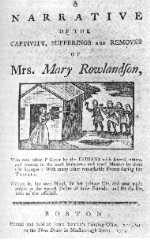Rowlandson's
Narrative: Titles, Themes & Genres |
|
 |
Full Title (1677 ed.): A True History of the
Captivity and Restoration of Mrs. Mary Rowlandson, A Minister's Wife in New-England:
Wherein is set forth, The Cruel and Inhumane Usage she underwent amongst Heathens for
Eleven Weeks time: And her Deliverance from them. Written by her own Hand, for her Private
Use: and now made Public at the earnest Desire of some Friends, for the Benefit of the
Afflicted. Full Title (1773 ed.): A NARRATIVE of the Captivity, Sufferings and Removes of Mrs. Mary Rowlandson, who was taken Prisoner by the INDIANS with several others, and treated in the most barbarous and cruel Manner by those vile savages: With many other remarkable Events during her TRAVELS. |
| Question: What do the work's full titles
reveal about the work's purpose, intentions, and worldview? How does each title present
Rowlandson? How do they present the native tribes? What has changed between the two
titles? Themes
Genres captivity narrative: 1675-1740. These usually involved helpless women taken and returned. They expressed the community's sense of the event, helped to rationalize what had occurred, and helped them to move onto new life afterwards. travel narrative: Two ways to consider the travel narrative: one, as an expression of the personality and interests of the author, so much so that the theme and treatment of the theme count for more than the factual truth of the author's impressions; two, as works that successfully profile the people, objects, and places where they travel; the author is subsumed to the interest, even otherness, of another place and culture. jeremiad: These Puritan texts, often poems or sermons, stressed "the courage and piety of the founders, lamenting recent and present ills, and crying out for a return to the original conduct and zeal" (Elliott 257). Associated with the name and personality of Jeremiah, they are often considered prophetic, even angry, texts that call for public mourning and renewal of character.
Elliott, Emory. "The Jeremiad." in The Cambridge History of American Literature. Volume One: 1590-1820. Ed. Sacvan Bercovitch. Cambridge: Cambridge UP, 1997. |
|